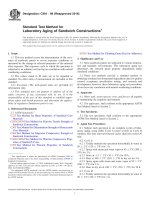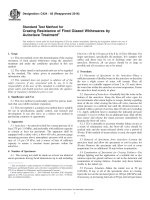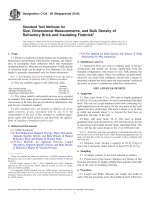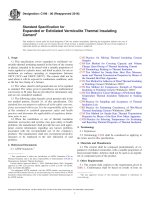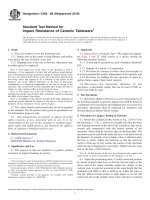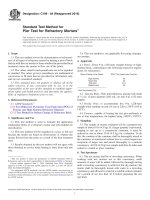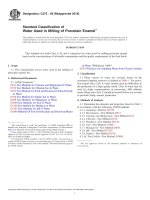Astm c 1545 02 (2016)
Bạn đang xem bản rút gọn của tài liệu. Xem và tải ngay bản đầy đủ của tài liệu tại đây (167.42 KB, 4 trang )
Designation: C1545 − 02 (Reapproved 2016)
Practice for
Dispersing Pigments and Other Materials into Water-Based
Suspensions with a High Intensity Mixer1
This standard is issued under the fixed designation C1545; the number immediately following the designation indicates the year of
original adoption or, in the case of revision, the year of last revision. A number in parentheses indicates the year of last reapproval. A
superscript epsilon (´) indicates an editorial change since the last revision or reapproval.
1. Scope
4. Significance and Use
1.1 In preparing ceramic glazes and slurries for use, it is
often necessary to add pigments to develop a desired fired
color, to incorporate viscosity control agents for developing, or
providing to develop the desired thickness of the glaze on the
ware, to add materials which stabilize the suspension, control
bacterial growth, and develop the desired hardness of the glaze
on the ware to allow moving and handling before firing. While
it is convenient to add these materials to the glaze or slurry in
the dry form, it is often possible to use slurries where these
materials are dispersed in a slurry and the slurry then added to
the liquid glaze. Regardless of the state of the additions (dry or
slurry), the dispersion can be done efficiently and effectively by
the use of a high intensity mixer (sometimes referred to as a
dissolver) and the procedure used is described here.
4.1 The traditional method of preparing glazes and slurries
has been to add stains (pigments), stabilizers, viscosity control
agents, bactericides, and so forth, to the pebble mill batch
along with normal batch materials such as clay, frit, quartz,
feldspar, whiting (calcium carbonate), zinc oxide, opacifier,
and so forth. This method had the disadvantage of over
grinding some of the materials of the batch and under grinding
other materials. While part of the disadvantage could be
alleviated by double or triple batching (where the pebble mill
was stopped at one or two points in the cycle and one or more
materials added), the practice was labor intensive and not
always well controlled. Another disadvantage of the traditional
method was that it was necessary to thoroughly wash out the
mill between batches of different colors. An obvious
advantage, however, was that small components of the batch
(such as pigments) were thoroughly dispersed in the batch and
even today it is necessary to use this procedure when small
quantities of strongly colored pigments are to be used.
1.2 The values stated in SI units are to be regarded as the
standard.
1.3 This standard does not purport to address all of the
safety concerns, if any, associated with its use. It is the
responsibility of the user of this standard to establish appropriate safety and health practices and determine the applicability of regulatory limitations prior to use.
4.2 With the advent of high speed intensive mixers using a
rotating shaft-mounted impeller, it is now the usual practice to
add pigments, conditioners, and so forth, to the batch from the
pebble mill and accomplish the same uniform dispersion as
would be the case if the pigments were milled in rather than
“stirred” in. In addition, the pigments tend to yield a stronger
color in the glaze because they have not been over ground in
the pebble mill. It is not uncommon to make a reduction in the
amount of pigment needed to develop the desired color when
the pigment is stirred in rather than milled in. An even greater
benefit is using the “stirred in” technique is that a single large
batch of a base glaze (for example, clear) can be made by
milling, and individual colors developed by stirring appropriate
pigments and conditioners into small amounts of the base
glaze. In this way, a large pebble mill can be dedicated to clear
base glaze and cleaning the mill between batches is not needed.
Glaze stains frequently are treated with proprietary materials
which assist in dispersing the stain into the glaze.
2. Referenced Documents
2.1 ASTM Standards:2
C242 Terminology of Ceramic Whitewares and Related
Products
3. Terminology
3.1 Standard terminology for ceramic whitewares and related products is given in Terminology C242.
1
This practice is under the jurisdiction of Committee C21 on Ceramic Whitewares and Related Products and is the direct responsibility of Subcommittee C21.03
on Methods for Whitewares and Environmental Concerns.
Current edition approved Nov. 1, 2016. Published November 2016. Originally
approved in 2002. Last previous edition approved in 2012 as C1545 – 02 (2012).
DOI: 10.1520/C1545-02R16.
2
For referenced ASTM standards, visit the ASTM website, www.astm.org, or
contact ASTM Customer Service at For Annual Book of ASTM
Standards volume information, refer to the standard’s Document Summary page on
the ASTM website.
5. Apparatus
5.1 There are two types of high intensity mixers
(dissolvers), those designed for laboratory use, where capacity
is approximately 10 to 15 litres of liquid, and those designed
Copyright © ASTM International, 100 Barr Harbor Drive, PO Box C700, West Conshohocken, PA 19428-2959. United States
1
C1545 − 02 (2016)
for production use, where capacity can be 1200 litres or more.
Typical characteristics of both types of mixer are shown in
Table 1.
5.2 Essential installation and operating “tips” for the mixers
are:
5.2.1 The motor power must be sufficient to maintain
desired speed with specified load.
5.2.2 The floor mounted model must be rigidly secured to
the floor.
5.2.3 A cylindrical container can be used for the glaze
whether it is laboratory or production equipment. Production
equipment must be fitted with a guide which centers and holds
in place the container on the same center as the impeller. A
rectangular container can be used, provided that the side and
bottom corners are well-rounded to avoid “dead” areas in the
mixture, just as is necessary with the bottom corner of the
round tub. A rectangular container has an advantage over the
round one in that there is less “spinning” of the glaze during
mixing. See Fig. 1 for details of a round tub.
5.2.4 There must be a guard for the impeller (production
machine) when the machine is not being used. This can be a
split disk of plywood slightly larger in diameter than the
impeller.
5.2.5 The drive unit must have sufficient vertical travel to
clear the tub when the tub is on a pallet.
5.2.6 The impeller size is determined by the size of the
container and the viscosity of the glaze. For a 1200 mm
diameter tank, the impeller should have diameter of 250 to 350
mm.
5.2.7 The speed of rotation, the viscosity of the liquid, the
size of the impeller, and the height of the impeller (from the
bottom of the tub) determine the effectiveness of mixing the
pigments into the glaze. The correct setting results in the depth
of the vortex being one third of the depth of the glaze batch
when at rest.
5.2.8 When there is no vortex, mixing will not be thorough;
when the vortex is too deep there will be considerable air
entrainment and splashing if the impeller is exposed. See Fig.
1 for a view of the recommended tub, and Fig. 2 for the tub,
impeller, and pattern of liquid flow.
FIG. 1
6.2 Add the desired amount of base glaze to the container.
The fill height should be no more than 80 % of the height of the
container with the impeller in place. The dry weight of the base
glaze in the container can be obtained by the use of a percent
solids vs. specific gravity curve, the weight of base glaze in the
container, and (from the curve) the percent solids in the glaze.
An example of the percent solids vs. specific gravity curve is
shown in Fig. 3. See 4.4 for the procedure for developing this
curve.
6.3 Start the dissolver at a low speed and if necessary, adjust
the height of the impeller to avoid splashing and to develop the
desired vortex. Extremely fluid base glazes may require a
smaller diameter impeller or a lower level of the base glaze in
the container. Continue stirring for a few minutes.
6.4 Knowing the dry weight of the base glaze in the
container, calculate the weight of the pigments and conditioners to be added, weigh these materials and add slowly (in the
center of the vortex) to the container, increasing the speed of
the dissolver if necessary to develop a good vortex. It may be
necessary for better dispersion to make a slurry of the pigments
and conditioners with a small amount of the base glaze and add
the slurry to the container rather than the dry materials.
6. Procedure
6.1 It is convenient to standardize on one size of container
(for example, 1200 mm diameter × 1200 mm height).
6.5 Mix the glaze, pigments, conditioners, and so forth, for
15 to 20 min (time depends on the types and amounts of
materials being added), stop the dissolver and take the required
sample for testing (viscosity, fired color, and so forth). Excessive mixing time, especially with a high viscosity glaze, will
increase the temperature of the glaze in the tub, as well as
shortening the life of the impeller.
6.5.1 Rules for glaze storage:
6.5.1.1 Always keep tight-fitting covers on glaze tubs.
6.5.1.2 Tubs must be washed and cleaned thoroughly after
one batch is finished and before another batch (even if the same
color) is added.
TABLE 1 Characteristics of Intensive MixersA
Capacity (litres)
Motor power (KW)
Motor speed (RPM)
Shaft speed (RPM)
Typical tank diameter (mm)
Typical tank height (mm)
Mounting
Tachometer on shaft
Hydraulic lift for drive and shaft
Laboratory
10 to 15
0.75
0 to 16000
0 to 16000
200
N/A
Bench
Yes
N/A
Production
1000 to 1500
7.5 to 25.0
1800
850 to 1500
1200
1200
Floor
Yes
Yes
A
From a Morehouse-Cowles information sheet
2
C1545 − 02 (2016)
FIG. 2
7.2 The machine must be in direct line of sight with the
“start/stop” button.
7.3 The employer shall have a program to ensure that the
machine cannot be energized accidentally during cleaning or
repair of the machine.
7.4 The walls of the container can easily be damaged if the
revolving dissolver blade contacts them.
7.5 Inspect the blade once a week to determine the amount
of wear on the teeth. The more the teeth wear, the less effective
will be the mixing. It is false economy to keep a blade in
service with badly worn teeth.
7.6 An appropriate ventilation system should be installed to
protect employees from dust exposure during dry operations. If
such a system is not feasible, the employer should develop an
OSHA respiratory protection program.
7.7 Electrical connections and equipment must be properly
grounded, water-tight, and in compliance with all local electrical codes.
7.8 Surface dust and spills should be washed up as frequently as needed to keep the area clean. As the very minimum,
the floor of the glaze preparation area must be washed daily.
7.9 Bagged materials must be stored on pallets or racks,
never on the floor, and protected from water and dust.
6.5.1.3 Leaking tubs must be repaired (epoxy/fiberglass is
useful for repairing small holes or cracks) or discarded.
6.6 Developing the Percent Solids vs. Specific Gravity
Curve
6.6.1 The dry weight of solids per millilitre of slip is
calculated by Brongniant’s equation:
W d 5 ~ W S 2 W W!
where:
WS =
WW =
Wd =
SG =
(1)
slip weight/millilitre (in grams),
Weight of water/millilitre (in grams),
Dry weight/millilitre (in grams), and
Specific gravity of the dry material.
6.6.2 Substitute several values for WS, calculate the percentage of solids corresponding to these values, and finally plot the
several points on a percent solids vs. specific gravity curve as
shown in Fig. 3.
NOTE 1—Fig. 3 does not represent actual data and is shown here for
illustration only.
7. Safety and Health Precautions
7.1 The dissolver must be fitted with a guard that will ensure
that a hand or paddle cannot be placed in the machine while it
is in operation.
3
C1545 − 02 (2016)
FIG. 3
7.10 Drums of materials, liquid or dry, are to be kept on
pallets or racks and kept tightly covered and protected from
water and dust.
ASTM International takes no position respecting the validity of any patent rights asserted in connection with any item mentioned
in this standard. Users of this standard are expressly advised that determination of the validity of any such patent rights, and the risk
of infringement of such rights, are entirely their own responsibility.
This standard is subject to revision at any time by the responsible technical committee and must be reviewed every five years and
if not revised, either reapproved or withdrawn. Your comments are invited either for revision of this standard or for additional standards
and should be addressed to ASTM International Headquarters. Your comments will receive careful consideration at a meeting of the
responsible technical committee, which you may attend. If you feel that your comments have not received a fair hearing you should
make your views known to the ASTM Committee on Standards, at the address shown below.
This standard is copyrighted by ASTM International, 100 Barr Harbor Drive, PO Box C700, West Conshohocken, PA 19428-2959,
United States. Individual reprints (single or multiple copies) of this standard may be obtained by contacting ASTM at the above
address or at 610-832-9585 (phone), 610-832-9555 (fax), or (e-mail); or through the ASTM website
(www.astm.org). Permission rights to photocopy the standard may also be secured from the Copyright Clearance Center, 222
Rosewood Drive, Danvers, MA 01923, Tel: (978) 646-2600; />
4
